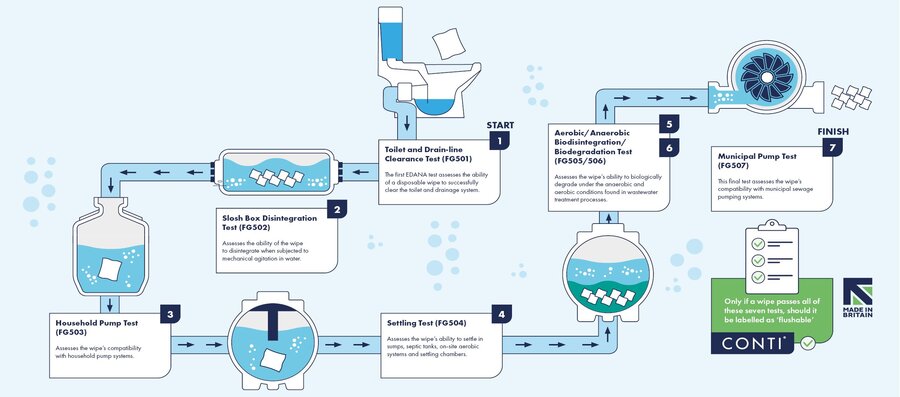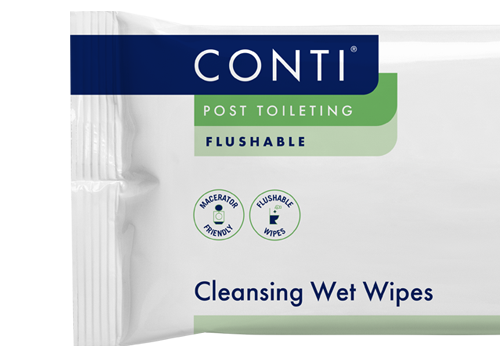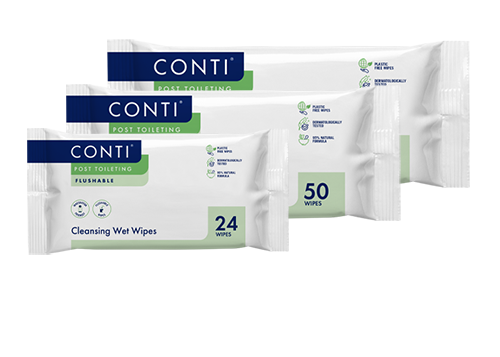
Are flushable wipes actually flushable?

Are flushable wipes actually flushable?

Are flushable wipes really flushable? The incorrect disposal of wet wipes is a hot topic at the moment, as our sewage systems suffer greatly when the correct guidance on flushable wet wipes is not followed. There are many ‘flushable’ wipe options available within the healthcare market, but are they truly flushable?
At Vernacare, we are committed to producing high-quality healthcare products with a strong emphasis on sustainability, without compromising on excellence. Within our premier Conti® collection, we have several flushable wet wipes available that can be disposed of in a toilet or a macerator.
This approach gives our professional team the knowledge to answer the question of 'Are flushable wipes really flushable?' clearly. Read on to find out more about flushable toilet wipes and how they work.
The Big Question: Can You Flush Wet Wipes?
In most cases, wet wipes and dry wipes should not be flushed down a toilet or disposed of in a macerator. This is because these wipes do not break down like toilet paper, which can cause serious problems to plumbing systems and wastewater treatment facilities.
As well as clogged pipes and blocked sewers, disposable wipes can also lead to 'fatbergs' - large masses of waste that can seriously block sewer systems. Unless you're absolutely certain that your wet wipes are flushable, you should dispose of them in a rubbish bin.
Many non-flushable wipes are made from synthetic fibres derived from plastic sources, such as polyester or polypropylene. These fibres can take hundreds of years to decompose and may release harmful microplastics into the environment.
If you want to avoid this, you should always choose a plastic-free wet wipe such as our Conti® Post Toileting Large wipes. These wipe products are instead made from cellulose fibres and are 100% plastic-free, able to be flushed easily or disposed of in a macerator after use.
Are Flushable Wipes Really Flushable?
Yes, flushable wipes really are flushable - if they have passed the official EDANA ‘GD4’ flushability standard.
However, the term 'flushable' can be misleading, as some companies market their wipes as being flushable because they can technically pass through your toilet and plumbing system. However, they may still cause issues within sewage systems, so it's important to only flush wipes that have passed the EDANA 'GD4' flush test.
Luckily, our collection of biodegradable flushable wipes meets EDANA's standards - read on to find out a little more about how it all works.
What makes a wipe flushable?
EDANA, the leading global association for the nonwovens industry, has worked for over a decade to define a series of rigorous dispersibility tests to determine whether wipe materials can be labelled as flushable, this is sometimes referred to as ‘GD4 Testing’.
To comply with the GDV testing requirements, the product must pass the seven tests below, as the results determine whether the wipes are actually flushable.
1.Toilet and Drain-line Clearance Test
The first EDANA test assesses the ability of a disposable wipe to successfully clear the toilet and drainage system.
2.Slosh Box Disintegration Test
Assesses the ability of the wipe to disintegrate when subjected to mechanical agitation in water.
3.Household Pump Test
Assesses the wipe’s compatibility with household pump systems.
4.Settling Test
Assesses the wipe’s ability to settle in sumps, septic tanks, on-site aerobic systems and settling chambers.
5/6. Aerobic/Anaerobic Bio-disintegration/Biodegradation Test
Assesses the wipe’s ability to biologically degrade under the anaerobic and aerobic conditions found in wastewater treatment processes.
7. The final test assesses the wipe’s compatibility with municipal sewage pumping systems.
Only if a wipe passes all of these seven tests should it be labelled as ‘flushable’.
At Vernacare, we’re pleased to announce that we manufacture a range of plastic-free, flushable Conti® Post Toileting wipes, which can be disposed of in either a toilet or a macerator. These wipes have passed EDANA’s GD4 testing requirements, ensuring they are suitable for flushing.

How Do You Determine if a Wipe is Flushable?
Now you’re familiar with the rigorous testing procedure a flushable wipe must go through, the next question is: How can we tell by looking at a wipe if it is flushable or not?
Vernacare’s collection of flushable wipes and maceratable wipes are made from cellulose-based fibres and are 100% plastic-free - this means that when touching these bathroom wipes, they will usually feel lighter than a traditional wet wipe.
However, it's important to note that the look and feel of a product shouldn’t be the sole factor in deciding what is and isn’t flushable. The packaging should clearly and correctly state how to dispose of the product - for example, the Conti® Post Toileting flushable packs clearly state that these wipes are flushable and macerator friendly.

Choose a Flushable Wipe with Vernacare
The question of ‘Are flushable wipes really flushable?’ is a difficult question to answer, as it’s highly dependent on the wipe itself. Some wet wipes claim to be flushable when they’re actually not, so it’s important to ensure that you only flush wipes that have passed EDANA’s stringent GD4 tests.
Available in pack sizes of 24 and 50, the Conti® Post Toileting wipes are a sustainable and plastic-free, flushable alternative to traditional toilet paper for intimate hygiene, created with a 95% natural formula.
Designed for everyday continence care and intimate hygiene, these dermatologically tested wipes are gentle to the skin and provide long-lasting moisture, with the added convenience of safe and hygienic disposal in a toilet or macerator.
We also manufacture a range of non-flushable wipe products - please see our entire waterless bathing selection here.
